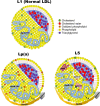Comparative Analysis of Atherogenic Lipoproteins L5 and Lp(a) in Atherosclerotic Cardiovascular Disease
- PMID: 38753254
- PMCID: PMC11192678
- DOI: 10.1007/s11883-024-01209-3
Comparative Analysis of Atherogenic Lipoproteins L5 and Lp(a) in Atherosclerotic Cardiovascular Disease
Abstract
Purpose of review: Low-density lipoprotein (LDL) poses a risk for atherosclerotic cardiovascular disease (ASCVD). As LDL comprises various subtypes differing in charge, density, and size, understanding their specific impact on ASCVD is crucial. Two highly atherogenic LDL subtypes-electronegative LDL (L5) and Lp(a)-induce vascular cell apoptosis and atherosclerotic changes independent of plasma cholesterol levels, and their mechanisms warrant further investigation. Here, we have compared the roles of L5 and Lp(a) in the development of ASCVD.
Recent findings: Lp(a) tends to accumulate in artery walls, promoting plaque formation and potentially triggering atherosclerosis progression through prothrombotic or antifibrinolytic effects. High Lp(a) levels correlate with calcific aortic stenosis and atherothrombosis risk. L5 can induce endothelial cell apoptosis and increase vascular permeability, inflammation, and atherogenesis, playing a key role in initiating atherosclerosis. Elevated L5 levels in certain high-risk populations may serve as a distinctive predictor of ASCVD. L5 and Lp(a) are both atherogenic lipoproteins contributing to ASCVD through distinct mechanisms. Lp(a) has garnered attention, but equal consideration should be given to L5.
Keywords: Atherogenesis; Atherosclerotic Cardiovascular Disease; Electronegative LDL; L5; Lp(a); Oxidized LDL.
© 2024. The Author(s).
Conflict of interest statement
Chu-Huang Chen is President of HEART, Health Resource Technology, LLC, USA. Antonio M. Gotto serves as Editor-in-Chief of
Figures


References
Publication types
MeSH terms
Substances
LinkOut - more resources
Full Text Sources
Medical
Research Materials
Miscellaneous

